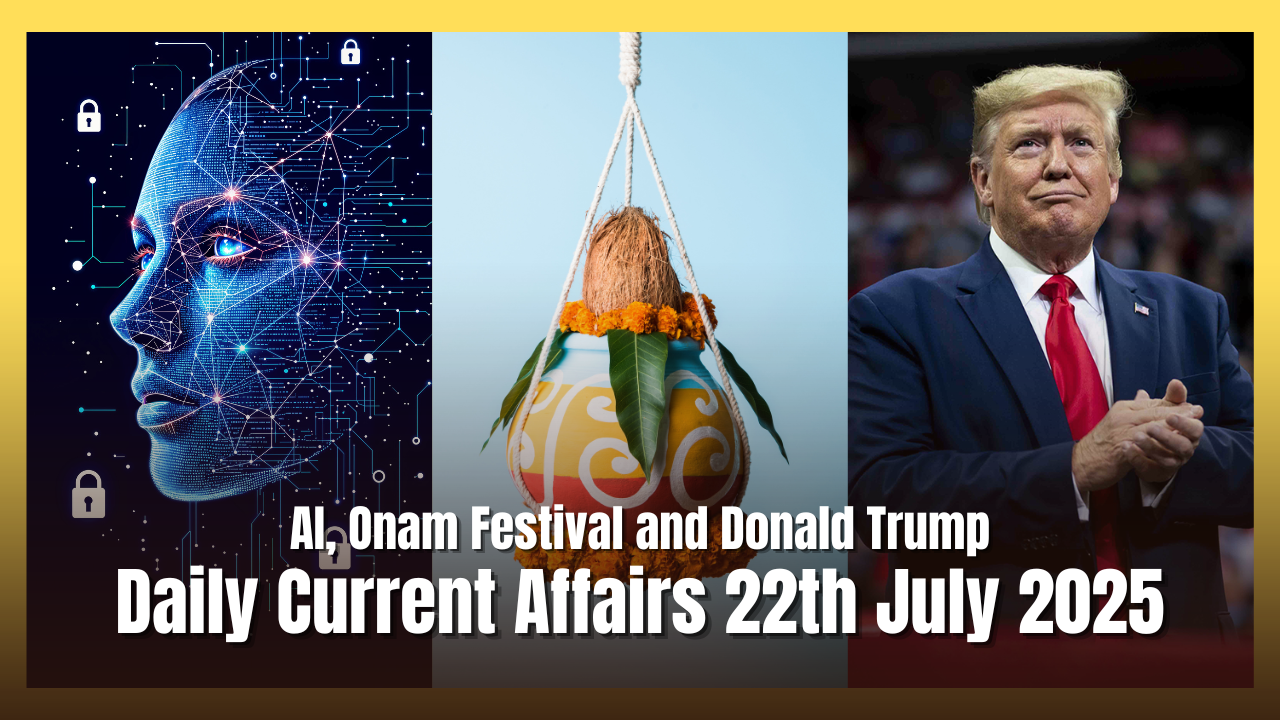Daily Current Affairs 22th July 2025
In this edition of Daily Current Affairs, we bring you concise and important updates on key national and international developments that are shaping the world today.
1) Onam
2) Reframing the Artificial Intelligence Debate
3) Global FDI and EMDEs
4) India’s Inflation Rate
5) Soil Health and Nutritional Security: A Critical Turning Point for India’s Future
6) Is Israel Committing Genocide in Gaza? A Powerful Legal Reckoning Unfolds at the ICJ
7) Discovery of Allographa effusosoredica
8) Arkavati River
9) Cognitive Fatigue
10) Chronic Venous Insufficiency
Onam
Context: As the festival season approaches, especially Onam, the soaring prices of coconut oil have become a major concern for households across Kerala.
About Onam
- Onam is the biggest and most significant festival in Kerala, India.
- Celebrated predominantly by Malayali communities, it is an annual harvest festival that falls in the Malayalam month of Chingam, corresponding to August–September in the Gregorian calendar.
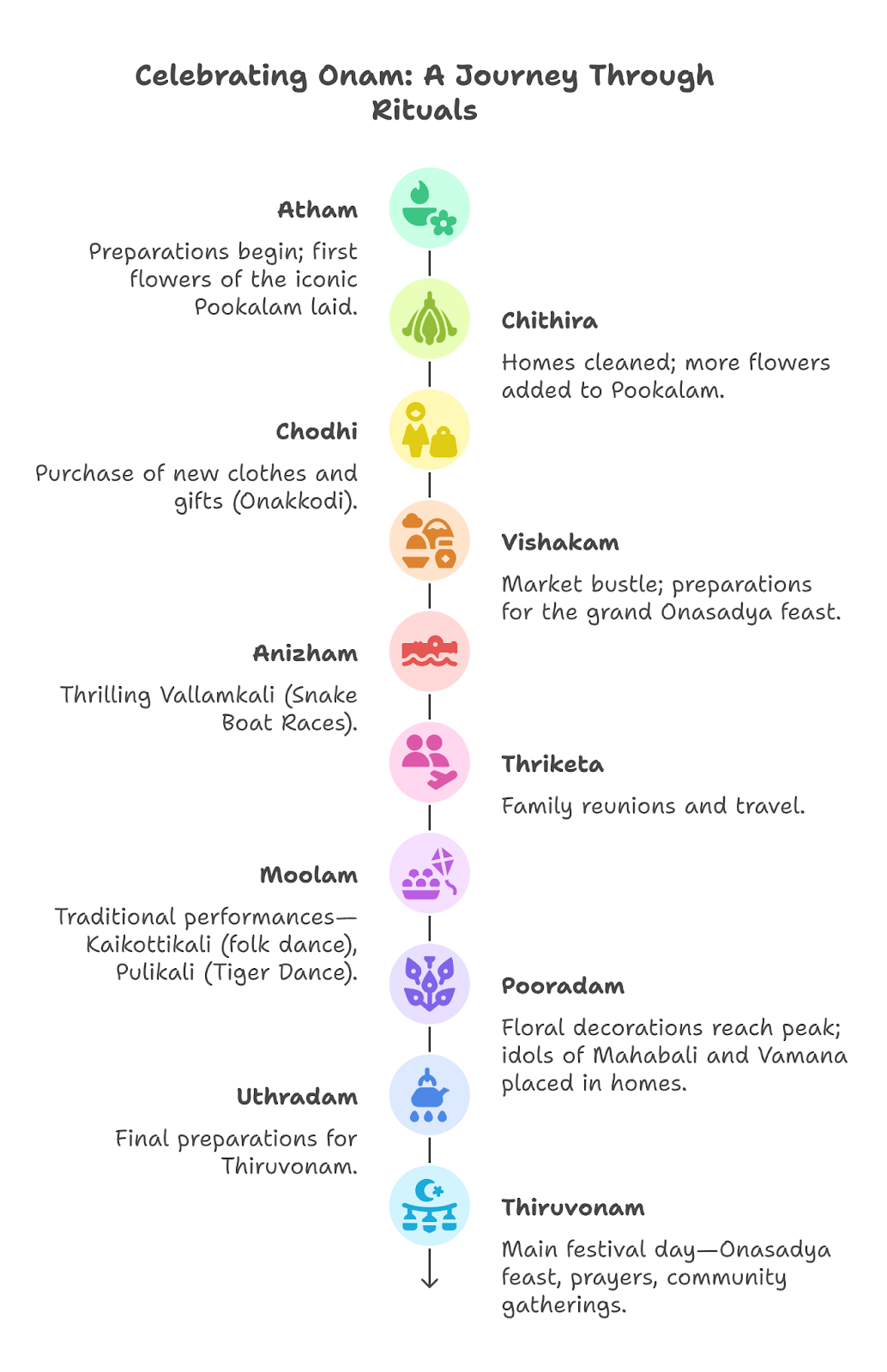
Mythological Origins
- Onam commemorates the annual homecoming of King Mahabali, a legendary ruler known for his generosity and prosperity.
- According to Hindu mythology, Mahabali was sent to the netherworld by Vamana, the fifth avatar of Lord Vishnu, who granted him permission to visit his beloved subjects in Kerala once every year.
- Onam marks this symbolic return and the people’s joyous welcome to their king.
Duration and Timing
- Onam is celebrated over ten days—from Atham to Thiruvonam, each day marked by unique rituals and fervour.
- The main day, Thiruvonam, is the grand finale featuring widespread community activities and feasting.
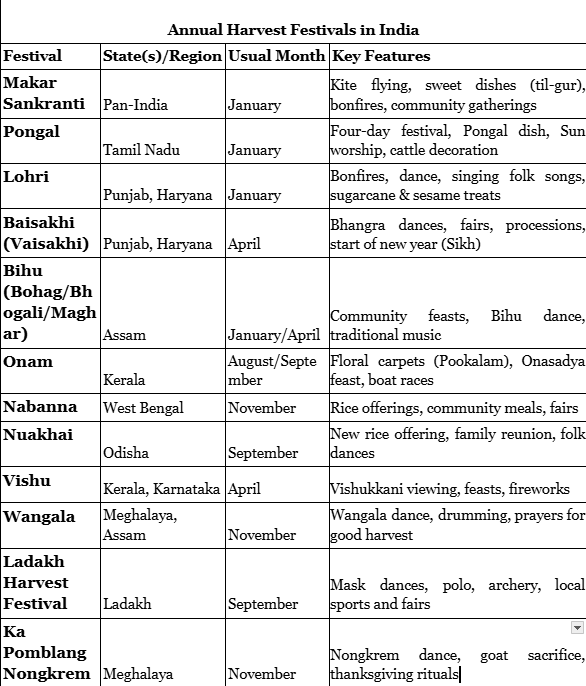
Reframing the Artificial Intelligence Debate
India can reframing the Artificial Intelligence debate
Context: Less than three years ago, ChatGPT brought artificial intelligence (AI) out of research labs and into homes, schools, and parliaments.
More on News
- Since then, AI has been a regular topic in global diplomacy, leading to three high-profile summits.
- Now, as India prepares to host the AI Impact Summit in February 2026, it has a historic opportunity — not just to gather global leaders, but to shape the global AI agenda for public good.
How Can India Bridge the Geopolitical Divide in AI Governance?
- The current global environment is anything but calm. The war in Ukraine rages on, West Asia remains unstable, and global trade is becoming increasingly protectionist. The Paris AI Summit (2025), aimed at building consensus, ended in disarray, with the U.S. and U.K. walking away from the final declaration, even as China welcomed it.
- India, with its strong diplomatic credentials and Global South leadership, has the potential to bridge this divide and offer a neutral, unifying platform.
What Makes India’s Approach to AI Consultation Unique?
- In June 2025, India’s Ministry of Electronics and Information Technology launched a nationwide consultation via the MyGov platform.
- Students, startups, civil society actors, and researchers contributed ideas focused on inclusive growth, sustainable development, and environmental protection through AI.
- This open, democratic process — unlike any adopted by previous summit hosts — ensures that India’s agenda is people-driven, not corporate-controlled.
Should AI Pledges Be Backed by Public Report Cards?
- Just like Aadhaar and UPI made digital services accessible for billions, the 2026 Summit can encourage each participating country or institution to commit to a tangible AI goal.
- For example: A tech company could pledge to cut data centre emissions, A university might run a free AI course for rural students and A government could use AI to translate health information into local languages.
- These pledges should be published on a public platform and tracked for accountability. After all, transparent report cards spark more change than generic declarations.
How Can India Champion the Global South in AI Policy?
- At the first AI summit, many Global South countries were notably absent from leadership roles. India must ensure inclusive representation this time.
- A key proposal: launch an “AI for Billions Fund” with support from development banks and Gulf nations. The fund would support Cloud credits for researchers, Multilingual AI datasets and Fellowships for underserved regions.
- India could even host a Multilingual AI Model Challenge targeting 50 underrepresented languages — a move that democratizes both talent and technology.
Is a Global AI Safety Protocol Achievable?
- Since the Bletchley AI Safety Summit (2023), there has been a push for red teaming and model stress testing. Yet no global checklist or shared protocol exists.
- India can propose a Global AI Safety Collaborative, where national institutes share incident logs, Exchange red team scripts and Post open evaluation kits for AI testing.
- A shared benchmark for safety will bring greater trust, transparency, and alignment across borders.
Can India Offer a Balanced Path on AI Regulation?
- AI regulation currently splits the world:
-
- The U.S. fears over-regulation.
- Europe is implementing the AI Act.
- China uses top-down control.
- India can advocate for a middle path. It could promote a voluntary but enforceable AI code of conduct, rooted in global best practices but adapted to diverse national contexts.
- Key suggestions: Public red team results within 90 days, Disclosure of compute usage after a threshold and Establishment of an accident reporting hotline.
Why Is Avoiding Summit Fragmentation Crucial?
- The risk of AI summits turning into geopolitical echo chambers is real. U.S.–China rivalries loom large.
- India cannot erase these divides, but it can broaden the agenda and keep the focus on global welfare.
- A successful summit must prioritise Inclusivity, Concrete outcomes and Shared tools and resources.
- India can position itself as a stabilising force in AI geopolitics, not by dominating the agenda but by aligning fragmented efforts.
What’s at Stake for India at the AI Impact Summit 2026?
- India doesn’t need to build a global AI authority from scratch. But it can stitch together what already exists, promote democratic access to AI tools, and ensure Global South participation.
- If it succeeds, India will not just host a summit — it will redefine its global role in the age of artificial intelligence.
Global FDI and EMDEs
India’s FDI challenge
Context: The global landscape of foreign direct investment (FDI) is undergoing a significant transformation.
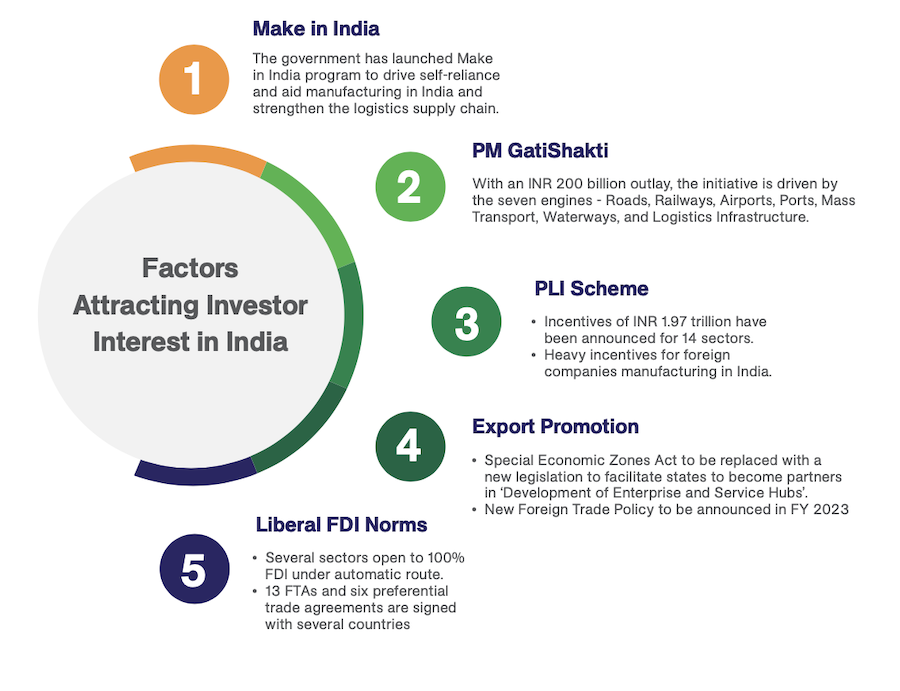
What is the Present Status?
- According to the World Bank, FDI inflows to emerging markets and developing economies (EMDEs) have steadily declined since the 2008 global financial crisis, falling to just 2% of GDP in recent years.
- In absolute terms, EMDEs received $435 billion in FDI in 2023, the lowest since 2005.
- This slump contrasts sharply with the 2000s boom, when FDI to EMDEs surged fivefold, peaking at 5% of GDP in 2008.
- The current slowdown is no longer cyclical — it’s structural, driven by: Geopolitical uncertainty, Protectionist trade and investment policies, Policy inertia and A slowdown in investment treaties.
- Between 2010 and 2024, only 380 new investment treaties came into effect, compared to over 870 in the previous decade.
How Is India Navigating the Global FDI Downturn?
- India is relatively better positioned but isn’t immune to global headwinds.
- While gross FDI inflows touched a strong $81 billion in FY25 (up 14% year-on-year), net FDI plummeted 96% to just $0.35 billion — the lowest in nearly 20 years.
- This steep fall is attributed to: Rising profit repatriation, Growing outward FDI from Indian firms and Low reinvestment of earnings.
What Sectors and States Are Driving FDI in India?
- The composition and geography of FDI are evolving. Globally, sectors like clean energy, services, and construction are attracting more greenfield investments than traditional manufacturing.
- In India, manufacturing and financial services remain key FDI magnets.
-
- The energy and communications sectors are seeing rising interest.
- States like Maharashtra, Karnataka, and Tamil Nadu have seen increased FDI, while Gujarat and Delhi experienced declines.
Can Strategic Trade Deals Boost India’s FDI Inflows?
- A key strategy is embracing free trade agreements (FTAs) and reducing skepticism toward international trade.
- Recent deals with Australia, UAE, and UK, and a potential US trade deal, signal India’s pivot toward trade integration.
- According to the World Bank: FTAs raise bilateral FDI flows by over 40%.
- A 1 percentage point increase in trade-to-GDP ratio leads to 0.6% higher FDI inflows.
- A 1 percentage point rise in value-added trade boosts FDI by 0.3%.
- In a geopolitically charged world, FDI is increasingly flowing to aligned partners, making FTAs more critical than ever.
Why Must India Prioritise Deregulation and Contract Enforcement?
- The Economic Survey has emphasised the need for deeper deregulation.
- Establishing a Deregulation Commission could be key to: Reducing bureaucratic red tape, Enhancing investor confidence and Ensuring quick and fair contract enforcement.
- Simplified regulatory frameworks help firms operate efficiently and attract long-term FDI.
How Can Logistics and Port Efficiency Improve India’s FDI Climate?
- Logistics bottlenecks are a major barrier to trade and investment. Despite efforts, challenges persist:
- Port inefficiencies lead to long cargo clearance times. For instance, Kolkata Port averages 140+ hours for import clearances.
- Addressing these through digitisation, customs reform, and port modernisation can significantly improve investor sentiment.
Why Is Institutional Coordination Key for Investment Reforms?
- In today’s globalised economy, coherent policy coordination across central ministries, state governments, and regulatory agencies is essential.
- India must align domestic reforms with international rulemaking, encourage a whole-of-government approach to investment promotion and enable smooth collaboration between Centre, states, and industry stakeholders.
India’s Inflation Rate
Why food inflation may remain low
Context: In June 2025, India’s consumer price index (CPI) inflation stood at 2.1% year-on-year, lower than 2.7% in the US and 3.6% in the UK.

More on News
- The contrast was even starker in food inflation: -1.1% in India, compared to 3% in the US and 4.5% in the UK.
- This decline in both headline retail and consumer food inflation — now at their lowest since January 2019 — comes as a major relief for the Reserve Bank of India (RBI), which had struggled to contain inflation for much of 2023 and 2024.
How Did the 2024 Surplus Monsoon Help Reduce Food Inflation?
- India’s prolonged food inflation was largely curbed due to a bumper monsoon in 2024, which was 7.6% above the long-period average (LPA). This resulted in robust kharif (monsoon) and rabi (winter) crop harvests.
- As market arrivals of crops surged, food prices stabilised. By early 2025, the pressure on food inflation began easing, eventually slipping into deflationary territory by June.
What Is the Impact of Higher Cereal Stocks on Inflation?
One of the most significant gains from the surplus rainfall has been in wheat production and procurement:
- Government wheat stocks as of July 1, 2025, stood at 358.78 lakh tonnes, a four-year high.
- This marks a strong recovery from the 2024 level of 282.61 lt, which was close to the buffer norm of 275.80 lt.
- Similarly, record stocks of rice add to the overall stability in cereal supply, empowering the government to meet Public Distribution System (PDS) requirements and intervene in open markets to cool prices if needed.
Has the 2025 Monsoon Strengthened Kharif Crop Planting?
- The 2025 monsoon arrived early, setting in over Kerala on May 24 — eight days ahead of schedule.
- India recorded 7.1% excess rainfall between June 1 and July 20. Most regions, except a few like Telangana, Bihar, and parts of Northeast India, have received surplus rains.
- This has boosted sowing of most kharif crops, though acreage of arhar, soyabean, and cotton has declined — not due to rainfall, but due to price disincentives.
Why Are Farmers Shifting From Pulses and Oilseeds to Maize?
- The decline in the area under crops like arhar (pigeon pea) and soyabean is mainly due to market prices falling below the Minimum Support Prices (MSP), with arhar trading at around ₹6,500/qtl against an MSP of ₹8,000, and soyabean at ₹4,300/qtl compared to the ₹5,328 MSP.
- Instead, farmers are planting maize, which is increasingly used for fuel ethanol, animal feed, and industrial starch, making it a more remunerative option.
How Will Edible Oil Imports Help Manage Food Inflation?
- On May 31, 2025, the Indian government slashed the effective import duty on crude palm, soyabean, and sunflower oil from 27.5% to 16.5%.
- This move aims to reduce the landed cost of key cooking oils and prevent global price volatility from affecting domestic food inflation.
What Is the Road Ahead for India’s Food Inflation Outlook?
- With two back-to-back good monsoons, high cereal stocks, increased imports of pulses and edible oils, and early kharif sowing, India is well-positioned to keep food inflation in check.
- However, vigilance is necessary to monitor monsoon consistency through August and September, address fertiliser supply gaps, and ensure timely imports and price support where needed.
Soil Health and Nutritional Security: A Critical Turning Point for India’s Future
Soil Health and Nutritional Security: Empowering India Through Scientific Soil Management
Context: In present-day India, despite record food grain production and large-scale food distribution through schemes like PM-Garib Kalyan Yojana, malnutrition remains alarmingly high. The core issue lies in declining soil health, which affects both crop yield and nutritional quality.
What is the link between soil health and human nutrition?
- Definition and Relevance of Soil Health: Soil health refers to the capacity of soil to function as a living system, supporting plant, animal, and human life.
Why is this not just an agricultural issue but a public health crisis?
- Malnutrition Despite Food Security: Even though India has achieved substantial food security, nutritional indicators remain poor.
-
- According to NFHS-5 (2019–21): 35.5% of children under five are stunted, 32.1% are underweight & 19.3% are wasted.
- India’s Dual Paradox: India today is the world’s largest rice exporter and runs the world’s biggest food distribution programme — the PM-Garib Kalyan Yojana — covering over 800 million beneficiaries. Simultaneously, it suffers from a high burden of malnourishment.
- For optimal productivity and nutrition, soil must be rich in macronutrients (Nitrogen, Phosphate, Potash) and micronutrients (Zinc, Iron, Boron) along with adequate Soil Organic Carbon (SOC).
- Soil Deficiencies Lead to Nutritional Deficiencies: Crops grown in nutrient-deficient soils reflect these gaps. Their nutritional profile degrades, directly impacting human health.
- This causes “hidden hunger” — a type of micronutrient malnutrition. For example, zinc-deficient soils result in zinc-deficient wheat and rice, which contributes to childhood stunting and long-term cognitive delays.
Where is India’s soil health most compromised?
- National-Scale Deficiency Data: As per Soil Health Card Scheme (2024) data from over 8.8 million samples: Fewer than 5% of soils have sufficient Nitrogen (N), Only 40% are sufficient in Phosphate (P), 32% are adequate in Potash (K), Only 20% meet SOC standards. This reveals a crisis of macro- and micronutrient availability in Indian soils.
- Regional Imbalances in Fertiliser Use: : In Punjab, Nitrogen usage exceeds recommended levels by 61%, but Potassium is 89% below requirement and Phosphorus by 8%. In Telangana, Nitrogen is overused by 54%, while Potassium and Phosphorus are underused by 82% and 13%, respectively.
When did fertiliser imbalances become a serious issue?
- Declining Fertiliser Efficiency: India’s fertiliser-to-grain response ratio has sharply declined from 10:1 in the 1970s to just 2.7:1 by 2015, reflecting growing inefficiency and overreliance on fertilisers.
- Urea Overuse and Its Consequences: Subsidised granular urea is overapplied, but only 35-40% of Nitrogen is actually absorbed by crops.
What are the broader policy implications of poor soil health?
Who is addressing the soil-nutrition crisis?
- ICRIER and OCP Nutricrops have partnered to develop region-specific, data-driven soil nutrition solutions to improve crop productivity and nutritional quality.
- The initiative promotes sustainable food systems that benefit both farmers and consumers.
- Environmental Fallout: Overapplication of nitrogen leads to water pollution, air pollution, GHG emissions and desertification.
- Economic and Public Health Burden: Subsidy costs are spiraling — exceeding ₹2 lakh crore annually. Poor-quality crops perpetuate malnutrition, increasing healthcare expenditure and productivity loss.
- International Best Practice: Embrapa in Brazil has successfully demonstrated how region-specific soil research, strong public-private coordination, and farmer training can reverse soil degradation and improve output. India can replicate this through synergy between ICAR, state agri universities, and private innovators like IFFCO and OCP.
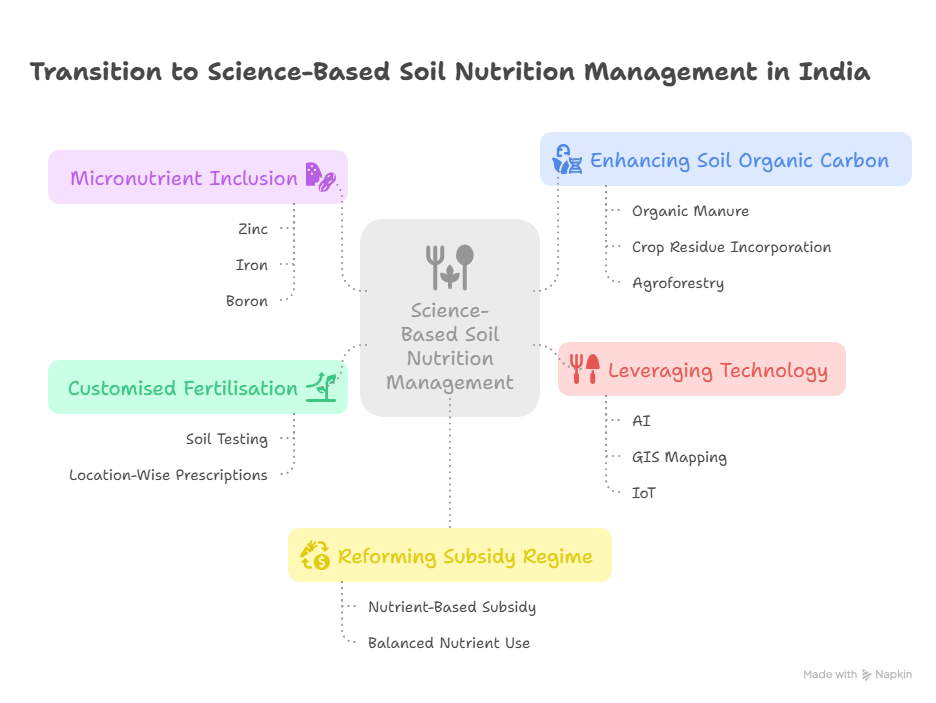
What should be the roadmap for policymakers?
- Short-Term: National Mission on Soil Nutrition: A National Soil Nutrition Mission must be launched, bringing together ministries of agriculture, health, and environment.
- Medium-Term: Link Soil and Food Distribution: Grains distributed via PDS must reflect nutritional values tied to soil health. Farmers adopting healthy soil practices should be rewarded through carbon credits and sustainability incentives.
- Long-Term: Institutional Reforms: Soil health indicators should be included in crop insurance schemes. Farmer education and agricultural curriculum must include modules on soil microbiology, nutrient management, and ecological farming.
Is Israel Committing Genocide in Gaza? A Powerful Legal Reckoning Unfolds at the ICJ
Is Israel Committing Genocide in Gaza? Unpacking a Growing Global Outcry
Context: In January 2024, South Africa brought a case against Israel at the ICJ under the 1948 Genocide Convention, alleging genocide in Gaza following the October 7 Hamas attacks. While the ICJ has not ruled on the merits, it issued binding provisional measures, indicating a “plausible risk” of genocide.
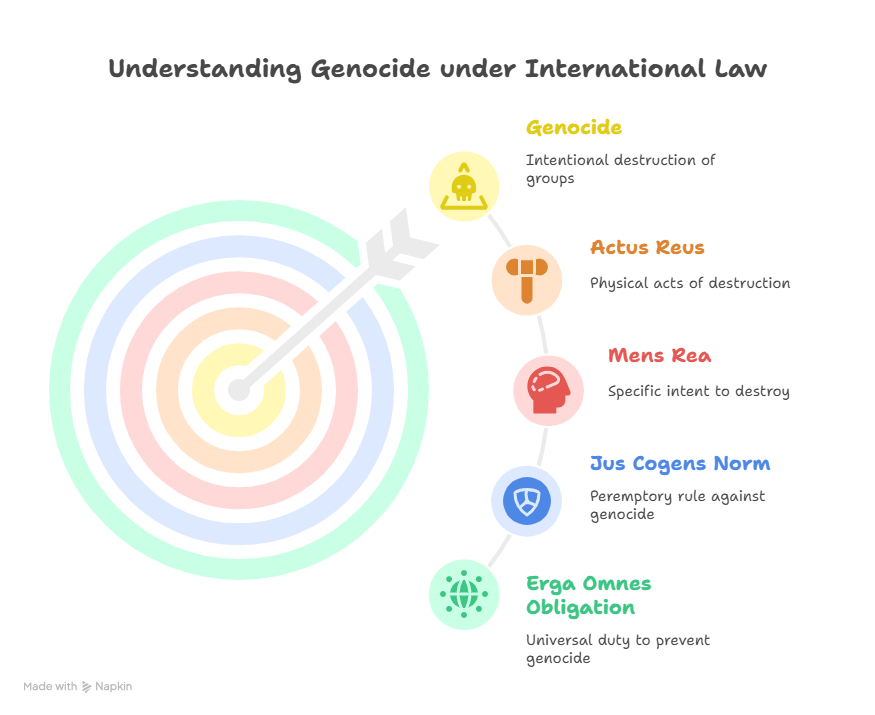
Why did South Africa initiate the genocide case against Israel?
South Africa cited its erga omnes obligation under the Genocide Convention, which empowers all parties to act against genocide. It claimed that:
- Israel’s military campaign in Gaza is not simply aimed at Hamas but amounts to the systematic destruction of Palestinian life.
- Israel is violating the Genocide Convention by killing civilians, starving populations, and destroying the means of survival in Gaza.
- South Africa also accused Israel of “weaponising humanitarian law” by distorting principles such as collateral damage and human shields, thus undermining civilian protections under international law.
Where does the evidence for genocidal intent come from?
Genocidal intent is difficult to prove, but the ICJ allows it to be inferred from circumstantial evidence, such as: Scale and pattern of conduct, Systematic destruction of civilian infrastructure & Dehumanising statements by officials. Key Evidence Cited:
- Francesca Albanese, UN Special Rapporteur, reported “reasonable grounds” for believing Israel had crossed the genocide threshold.
- A June 2024 UN Commission of Inquiry found that over 90% of Gaza’s schools and universities were destroyed.
- Death toll: As of July 2024, over 58,000 Palestinians, including 17,000+ children, have been reported killed.
- A joint UNHCR report (May 2024) by researchers from BU Law, Yale, Cornell, and University of Pretoria concluded that Israel’s conduct meets the threshold of genocidal acts and intent, citing starvation, targeted destruction, and disproportionate military tactics.
Who supports or contests the charge of genocide against Israel?
-
Supporting the Charge:
-
-
- UN Special Committee on Israeli Practices (Nov 2024): Accused Israel of using starvation as a method of war, systematic destruction of infrastructure, and AI-assisted bombings with minimal civilian safeguards.
- International Criminal Court (ICC): In May 2024, sought arrest warrants for Israeli PM Netanyahu and Defence Minister Gallant for war crimes and crimes against humanity.
-
-
Contesting the Charge:
-
- Israel: Argues it targets only Hamas militants and that civilian casualties are unintended collateral damage.
- AJC (American Jewish Committee): Labels the genocide charge as politically motivated, stating that Israel is exercising its right to self-defence against a terrorist group that vows to eliminate it.
- Western governments like the U.S., UK, France, and Germany have issued muted responses, largely avoiding use of the term “genocide” and shielding Israel from accountability at the UN Security Council through vetoes.
How is the UN responding, and can stronger action be taken?
How do international laws balance self-defence and genocide prevention?
- Even in warfare, international humanitarian law (IHL) — particularly the Geneva Conventions — requires distinction, necessity, and proportionality.
- The UNHR report emphasises that self-defence does not permit genocide.
-
- The ICJ’s provisional measures are legally binding, but lack enforcement mechanisms. Israel has not fully complied, and the humanitarian situation has deteriorated.
-
When will the ICJ make a final ruling — and will it matter?
-
- The ICJ’s final judgment will take several years, following extended hearings. By then, the destruction in Gaza could be irreversible. Still, the case is widely seen as a test of the rules-based international order and the credibility of international law.
- The delay in adjudication has prompted criticism that legal processes are too slow to prevent mass atrocities.
What are the broader geopolitical implications?
- The U.S. has repeatedly vetoed UNSC ceasefire resolutions, isolating itself diplomatically.
- Global South nations, led by South Africa, are rallying for accountability and calling for a new multilateralism not dominated by Western interests.
- Israel’s actions are straining EU-Israel relations, particularly with Spain, Ireland, and Belgium, which have called for sanctions.
- The broader impact of this case could reshape the interpretation of genocide law, Impact Global norms around armed conflict & Challnege the future legitimacy of international institutions.
Discovery of Allographa effusosoredica
New Lichen species reveals ancient symbiosis in the Western Ghats
Context: A team of Indian scientists from the MACS-Agharkar Research Institute, Pune, has discovered a new species of lichen, Allographa effusosoredica, in the biodiversity-rich Western Ghats. The study uniquely combined classical taxonomy and modern molecular techniques to identify and characterise the species.
The Western Ghats, also known as the Sahyadri Hills, are among the most significant ecological and biodiversity hotspots in the world. Stretching over 1,600 km along India’s western coastline, they span across six states — Gujarat, Maharashtra, Goa, Karnataka, Kerala, and Tamil Nadu — and were designated a UNESCO World Heritage Site in 2012 for their unique ecological and evolutionary value. Acts as a monsoon barrier, intercepting the south-west monsoon winds.
What Are Lichens?
- Lichens are symbiotic organisms, formed by the association of a fungus (providing structure and protection) and a photobiont (green algae or cyanobacteria that capture sunlight and produce food).
- Despite their modest appearance, lichens play critical ecological roles: soil formation, feeding insects, and serving as sensitive bioindicators of environmental health.
Key Features of Allographa effusosoredica
- It is a crustose lichen with effuse soredia (powdery reproductive structures).
- Contains the rare chemical norstictic acid, which distinguishes it from similar species in the genus Allographa.
- The photobiont partner identified is a species from the genus Trentepohlia.
- Morphologically, it mimics Graphis glaucescens, which raises questions about evolutionary relationships within the Graphidaceae family.
Ecological and Scientific Significance
- First species of Allographa from India supported by molecular data.
- Enhances knowledge of lichen-algal symbiosis, supporting the idea of locally adapted photobionts.
- Adds to India’s lichen diversity inventory: the 53rd Allographa species reported from India, and the 22nd from the Western Ghats.
- Highlights the need for further molecular studies on Indian lichens, especially in biodiversity-rich regions.
Arkavati River
Bringing a ‘ghost river’ back to life
Context: Arkavati River, once the primary drinking water source for Bengaluru (1936–2000), is now highly polluted and often referred to as a “ghost river.”
More on News
- A 2024 report by Paani.Earth in collaboration with IIT Madras found every tested site along the Arkavathi exceeded national and international pollution standards.
- Contaminants included phosphates, persistent chemicals, and even dangerous substances like hexavalent chromium — making the water unsafe for even irrigation, despite being graded “safe” under India’s outdated pollution assessment system.
Government’s Rejuvenation Plan
- In June 2025, the Karnataka government announced a high-level expert committee to rejuvenate the Arkavati via a public-private partnership (PPP) model.
- BWSSB (Bangalore Water Supply and Sewerage Board) is spearheading the initiative with the goal to make the 54 km stretch from Nandi Hills to T.G. Halli “pollution-free.”
- The basin covers 1,400 sq. km and includes areas like Hesaraghatta, Madanayakanahalli, and parts of BBMP.
About Arkavati River
- The Arkavathi is an important mountain river of Karnataka and a significant tributary of the Kaveri River.
- It originates in the Nandi Hills in Chikkaballapura district, at an elevation of 1,478 meters, and winds its way for 190 km before merging with the Kaveri about 34 km south of Kanakapura in Ramanagara district.
- The river’s basin covers 4,150 sq. km, encompassing nearly one-third of Bengaluru city, and was historically central to the city’s drinking water supply.
- It feeds two critical reservoirs — the Hesaraghatta Reservoir (built in 1894) and Thippagondanahalli (T.G. Halli) Reservoir, both of which once provided drinking water to Bengaluru.
- Tributaries include Kumudavathi River, Suvarnamukhi River, Vrishabhavathi River (currently highly polluted).
Cognitive Fatigue
Mental fatigue can trick the brain into taking the easy way out
Context: A new study in the Journal of Neuroscience reveals that cognitive fatigue not only affects performance and focus but also biases decision-making, making people prefer easier tasks, even if they offer less benefit.
What is Cognitive Fatigue?
- Cognitive fatigue builds up with sustained mental effort, even during sedentary tasks.
- It makes people prefer easier tasks, even when the harder ones offer greater benefits.
- It’s a subjective experience—effort tolerance varies from person to person.

Why Does Cognitive Fatigue Happen?
- The brain expends energy to maintain concentration, leading to subjective feelings of effort.
- Different people have varying capacities—what feels easy for one may be difficult for another.
- Continuous mental exertion (e.g., working memory tasks) increases fatigue, altering choices.
How Was the Study Conducted?
- Participants: Healthy volunteers performed memory-based tasks.
- Easy Task: Recalling if the current letter matched the previous one.
- Hard Task: Recalling if the current letter matched one shown 2–6 letters earlier.
- After repeated hard tasks, participants reported fatigue. They were then given a choice: easy tasks for less money, and hard tasks for more money.
- Result: Fatigued participants preferred easier tasks despite lower rewards, while rested individuals chose harder tasks for higher pay.
What Did Brain Scans Reveal?
- fMRI scans tracked brain activity during decision-making.
- Key Brain Regions Involved:
-
- Dorsolateral Prefrontal Cortex (dlPFC): Activated during cognitive fatigue (located behind the forehead).
- Anterior Insula: Evaluates effort vs. reward; influenced by fatigue signals from dlPFC.
- Finding: Fatigue reduces perceived value of effort, making tasks seem harder than they are.
Can Fatigue Affect Performance?
- Surprisingly, despite feeling fatigued, participants’ task performance did not decline.
- Interpretation: Fatigue shifts preference toward easier tasks rather than impairing ability.
- Real-Life Example: When deadlines loom, people push through fatigue, but in low-stakes scenarios, they opt for easier choices.
Does Fatigue Influence Physical Effort Choices Too?
- Upcoming Study: Cognitive fatigue from mental tasks also makes people choose less demanding physical tasks (e.g., skipping the gym after a tiring workday).
- Suggests a neurobiological link between mental exhaustion and reduced physical effort.

What Are the Implications for Daily Life?
- Work & Productivity: Fatigue can lead to procrastination or opting for simpler tasks.
- Health & Fitness: Mental exhaustion may reduce motivation for exercise.
- Neurological Conditions: Fatigue is common in stroke, depression, anxiety, and chronic fatigue syndrome—understanding its neural basis could improve treatments.
How Can We Manage Cognitive Fatigue?
- Take Breaks: Regular pauses help reset mental energy.
- Reframe Tasks: Changing perspective (e.g., viewing exercise as stress relief) may reduce perceived effort.
- Prioritise High-Value Tasks: When stakes are high, people push through fatigue, but for less critical tasks, breaks are essential.
Chronic Venous Insufficiency
Trump has chronic venous insufficiency: Here is all you need to know about the leg condition
Context: US President Donald Trump has been diagnosed with Chronic Venous Insufficiency (CVI).
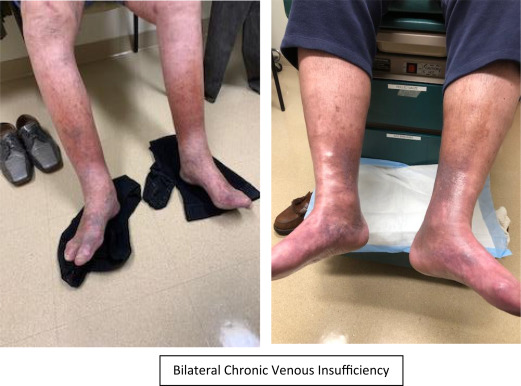
What is Chronic Venous Insufficiency (CVI)?
- Chronic Venous Insufficiency is a condition in which the veins in the legs struggle to send blood back to the heart.
- Under normal conditions, the veins contain tiny one-way valves that ensure blood flows only in the correct direction — upward toward the heart.
- When these valves become weak or damaged, blood can flow backward and accumulate or pool in the legs, particularly in the lower limbs.
- CVI is a slow-developing vascular condition that is closely linked to aging and lifestyle habits. It is particularly common in people over the age of 70.
- Though not considered life-threatening, CVI can become progressively uncomfortable and may lead to serious complications if not treated properly.
Symptoms and Effects of CVI
- The symptoms of Chronic Venous Insufficiency can range from mild to severe. Early indicators include:
- Swelling in the legs or ankles
- A feeling of heaviness or fatigue in the lower limbs
- Itching or tingling on the skin
- The development of varicose veins
- As the condition progresses, additional symptoms may appear, such as:
- Darkening, thickening, or leather-like texture of the skin
- The formation of open sores or ulcers, particularly around the ankles
- Persistent pain and discomfort
- These symptoms may gradually worsen over time, especially if the condition is left untreated.
Causes and Risk Factors
-
- CVI typically occurs when the valves inside the leg veins become damaged, often due to: Previous blood clots (such as Deep Vein Thrombosis), Leg injuries or trauma to the veins.
- Several risk factors increase the likelihood of developing CVI, including:
-
Prolonged periods of sitting or standing
-
- Obesity, which places additional pressure on the veins
- Pregnancy, due to increased blood volume and hormonal changes
- Smoking, which damages blood vessels and impairs circulation
- Low physical activity or sedentary lifestyle
- A family history of vein disorders
- All of these factors can weaken the structure and function of the veins over time, increasing the chances of developing CVI.
Treatment and Management
- Although CVI cannot be fully cured, its symptoms can be effectively managed to improve comfort and prevent complications.
Treatment options include:
- Lifestyle Changes: Engaging in regular physical activity, such as walking. Elevating the legs above heart level improves blood return. Maintaining a healthy body weight to reduce vein pressure
- Medical Therapies: Compression stockings to support blood flow and reduce swelling. Medications, including: Antibiotics for infected ulcers, Blood thinners to prevent clot formation, and Medicated wraps to support healing of skin ulcers.
- Advanced Procedures (for severe cases):
-
- Sclerotherapy: Injection of a chemical solution to close damaged veins
- Endovenous ablation: Use of heat energy (laser or radiofrequency) to seal veins
- Surgical intervention, when other methods are ineffective or complications arise
Treatment is generally customised based on the severity of the condition, the patient’s overall health, and the presence of any underlying risk factors.
Subscribe to our Youtube Channel for more Valuable Content – TheStudyias
Download the App to Subscribe to our Courses – Thestudyias
The Source’s Authority and Ownership of the Article is Claimed By THE STUDY IAS BY MANIKANT SINGH
